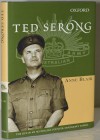Ted Serong
Written by: Anne Blair,
Oxford University Press, Melbourne, 2002,
ISBN: 9780195515923, 238pp.
Reviewed by: Major General Adrian Clunies-Ross (Retd)
Brigadier Ted Serong was a unique Australian soldier, and the essence of any biography of him would be to capture this uniqueness. This Anne Blair does to a considerable degree.
Serong is most widely identified with the Australian Army Training Team Vietnam (AATTV); this is not surprising since he led the first team to South Vietnam in 1962 and remained its nominal head until he left the Army in 1965. This connection with the team was, however, only one element of his career, which spanned a wide range of unusual activities and in which he wielded at times totally disproportionate influence.
The most significant landmark in Serong’s early career was the re-establishment of the of the Jungle Training Centre (JTC) in Queensland. Using techniques developed from World War II and the Malayan experience, JTC became the Army’s most important training institution at company level for Malaya, Borneo and South Vietnam, and continued for many years in much the same form that Serong had established. Nevertheless, as Anne Blair recounts and the Team experienced, its tactics and techniques required some modification for the much more substantial and intense conflict in South Vietnam.
Serong’s highly unusual service in Burma—first as a military attache and then as a special advisor to the Burmese Government—is well covered, but it is not until he arrived in South Vietnam in 1962 that he began to exercise extraordinary influence over the course of events and also over his allies. This influence is surprising in that, although he was appointed as a Special Advisor to the Commander of the Military Assistance Command (MACV), General Harkins, he commanded only thirty Australian Army advisors on the ground.
Anne Blair has dealt with the complexity of this appointment in some detail and with commendable insight. Serong had to deal not only with the initially skeptical Harkins, but also with the intrigue-ridden Vietnamese high command and more importantly with the suspicious President Ngo Dinh Diem, who was anxious to cultivate an ally as a counterweight to the Americans. That Serong was able to deal effectively with all three elements and to gain their trust and confidence was a tribute not only to his skill as a negotiator but also to his professional competence and extensive knowledge of counter-guerilla warfare. This influence was not limited to the players on the ground but extended to lecturing senior officer courses in the United States and face-to-face discussions with the highest in the land, including the Secretary of State and the President himself. It is obvious that the author regards this period as the high point of Serong’s career.
The book gives a detailed account of Serong’s activities after leaving the Army, including his establishment of a Police Field Force Training Centre at Trai Mat in the central highlands. This centre, based on Canungra-style training, was designed to produce a force capable of protecting the local population of the area from the Viet Cong (VC). Initially successful, this farsighted initiative went the way of many good ideas in Vietnam, destroyed by infighting and turf wars.
The closure of the training centre was followed by a gradual decline in Serong’s influence with both the Americans and the South Vietnamese, and in some cases open hostility to his ideas towards the end in 1975, although these ideas were still freely given. He was convinced that he had found the best tactical methods to be adopted by the South Vietnamese Army for the final battles of the war. Whether he was right or wrong did not matter at this point because, in marked contrast to the early years, no-one was listening.
What the book does not fully cover was Serong’s somewhat stormy relationship with his superiors. He was undoubtedly a difficult subordinate with a profound conviction in his opinions and judgment, and a highly independent streak. These characteristics did not always sit easily with those who had to deal with him. At the same time, as many will attest, he was generous to his subordinates, allowing them great flexibility and giving them unquestioning support. The book is a most readable account of a very unusual Australian soldier and should be consumed by all those who have an interest in the wider aspects of the Vietnam conflict. It does justice to a man whose unshakeable faith in his cause was the most compelling aspect of his character—a faith that sustained him through thirteen years of success and failure in South Vietnam.

